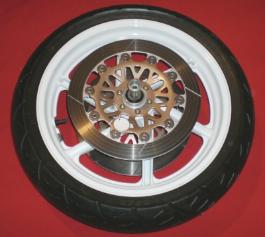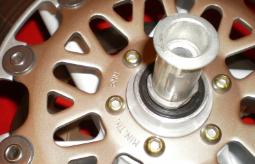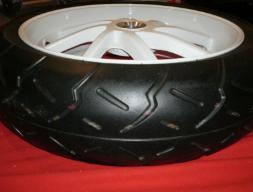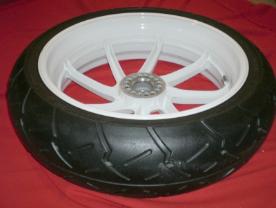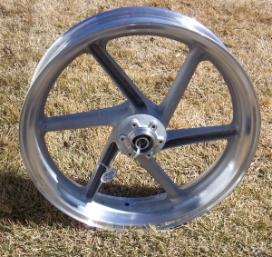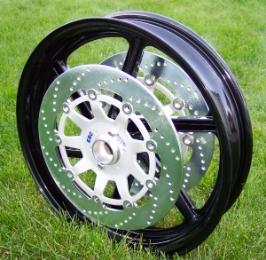Rear - Solution 5
May 11, 2012......Unfortunately
I had to update this section because Dunlop has ceased to manufacture
the 170/60-ZR18 (actually W rated). The Roadsmart has been replaced by
the Roadsmart II that only has a 160/60-18 rear tire now. This really
sucks. Hopefully they reconsider or someone else starts making a tire
suitable for the RC30 in a modern construction. The bold red strikeout
text below is no longer applicable.
Dec 17, 2012...... Well, looks like things have changed again. The new Dunlop Roadsmart is available in the correct 170/60-18 size, however it appears that only certain markets (Australasia etc) will be able to buy it.
Don’t do much of anything. Just go buy a 170/60R18
tire for the stock rim. This is, surprisingly, one of the best alternatives if
you don’t want to lay out the funds. Dunlop introduced a dual compound sport touring
tire called the Roadsmart in the exact right size, that being 170/60VR18. This tire, in spite of it being a "sport touring" tire
would be better than anything available for this bike back in the 1990’s. I
personally think Dunlop are out to lunch sometimes, but with this tire they
seem to have hit the nail dead on. It is worth mentioning there is one
other radial tire I know of. It is a Shinko Podium 006. Say what you want about them but
most of the Shinko tires get good reviews from the people who try them. I haven’t tried them so I won’t say anything other
than they make a correct size 170/60VR18 radial tire Shinko also make the matching 120/70ZR17 front tire so
there is no front to rear mismatch I have had problems with in the past. Shinkos run about 60% of the cost of the Dunlops. To the best of my knowledge these two setups are all that is made
in the exact right sizes as sets. There may be some bias tires out there also but I like radials.
I should mention that lots of
people would
say the Harley Davidson V-Rod tire (also a Dunlop) is available and will
spoon onto
the rim. Unfortunately it is a 180 section tire and, as mentioned
before, will be an interference concern. Try it if you want. It's not
really the best tire with no matching front either.
One variation of this option is
to install
a 160/60R18 tire. This size being narrower than the proper 170 section,
is narrow for a 5.5 inch wide rim. Most 160 width manufacturers
recommend a rim around 4.25" to 5" wide. 5.5" might be OK, but ALWAYS
check with the manufacturer of the rubber first. A good tire shop could
also probably advise. If you went this route you will find
there are some fairly good tires available but still mostly modern sport
touring tires. A suggestion when going this route would
be to mate it with a 110 section front tire to try to balance the
installed
profiles front to rear, especially if you are using the stock 3.0" wide
front wheel. With these relatively narrow tires you will end up with
a flatter cross-section.
A
ride height adjuster is needed if using a 160/60-18, same as with a17"
rim. A ride height adjuster is a good idea even with the stock 18" rear
and tire. RC30's sit low in the back and under power over bumps the tank
slappers show up. Jacking up the preload is not the answer to the
lowish rear.
Some of the better
rubber available in 160/60ZR18 just to ponder the possibilities. If one
of these was manufactured extra wide you'd effectively have the correct
size and might be able to skip the height adjuster. Not all tire
companies publish installed widths. You would have to extrapolate to a
5.5 inch wide rim anyway. Nobody gives an installed width for a 5.5 inch
wide rim, 4.5" seems to be the norm.
- Continental Conti Force (Sport touring - 161 wide on 4.25" rim - 649 diameter)
- Continental Conti Road Attack (Sport touring - 161 wide on 4.25" rim - 649 diameter)
- Avon AV56 Storm (Sport Touring - 167mm wide on 4.5" rim - 648mm diameter)
- Avon Storm 2 Ultra (Sport Touring - 168mm wide on 4.5" rim - 647mm diameter)
- Bridgestone BT023 (Sport Touring - 160 wide on 4.5" rim - 648 diameter)
- Bridgestone BT016 (High Performance - 160 wide on 4.5" rim - 648 diameter)
- Dunlop Sportmax (High performance - Looks like this one might be discontinued now)
- Metzeler Roadtec Z6 Interact (Sport Touring)
- Metzeler Roadtec Z6 (Sport Touring)
- Metzeler Roadtec Z4 (Sport Touring)
- Michelin Pilot Road 2 (Sport Touring)
- Pirelli Angel ST (Sport Touring)
